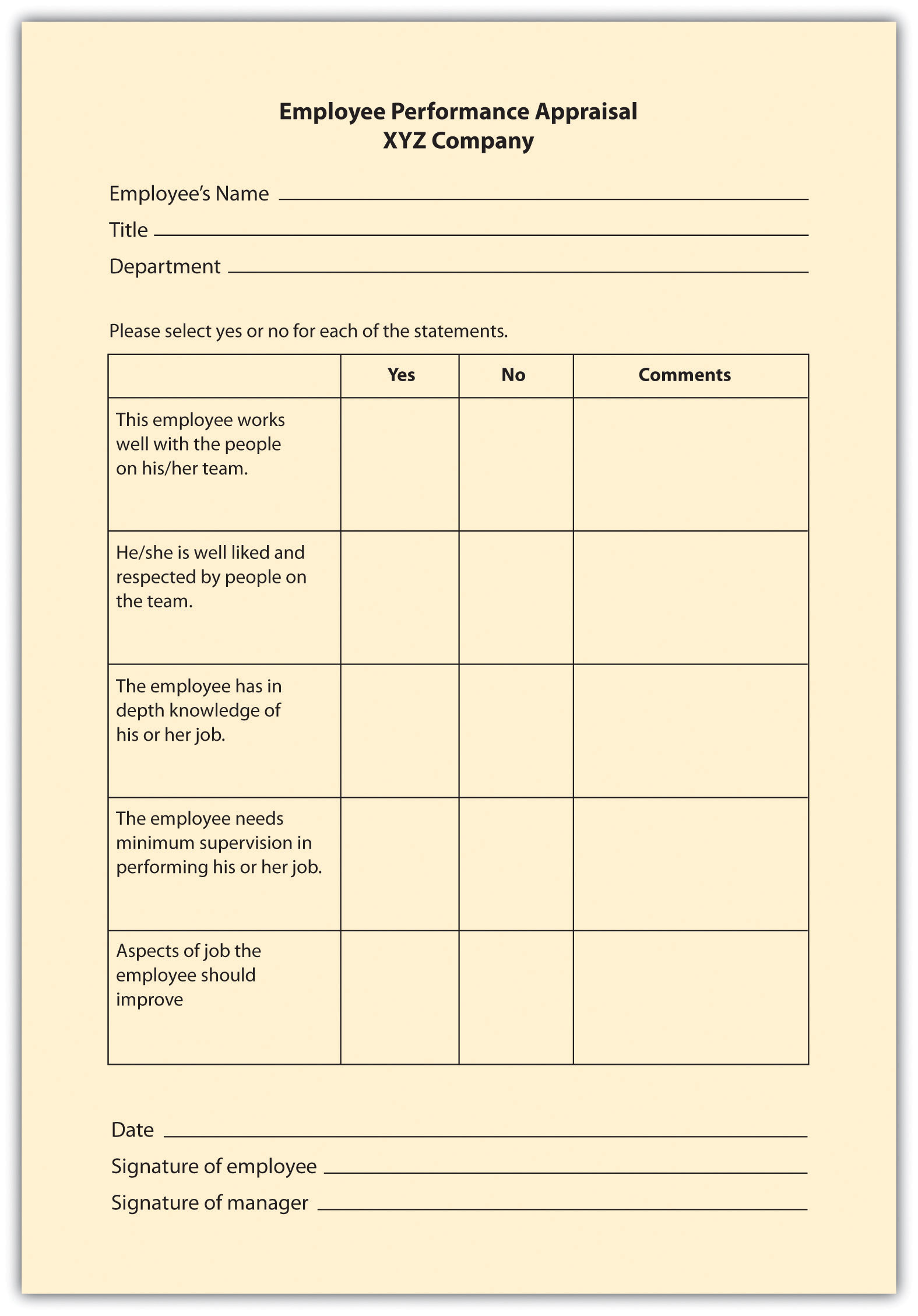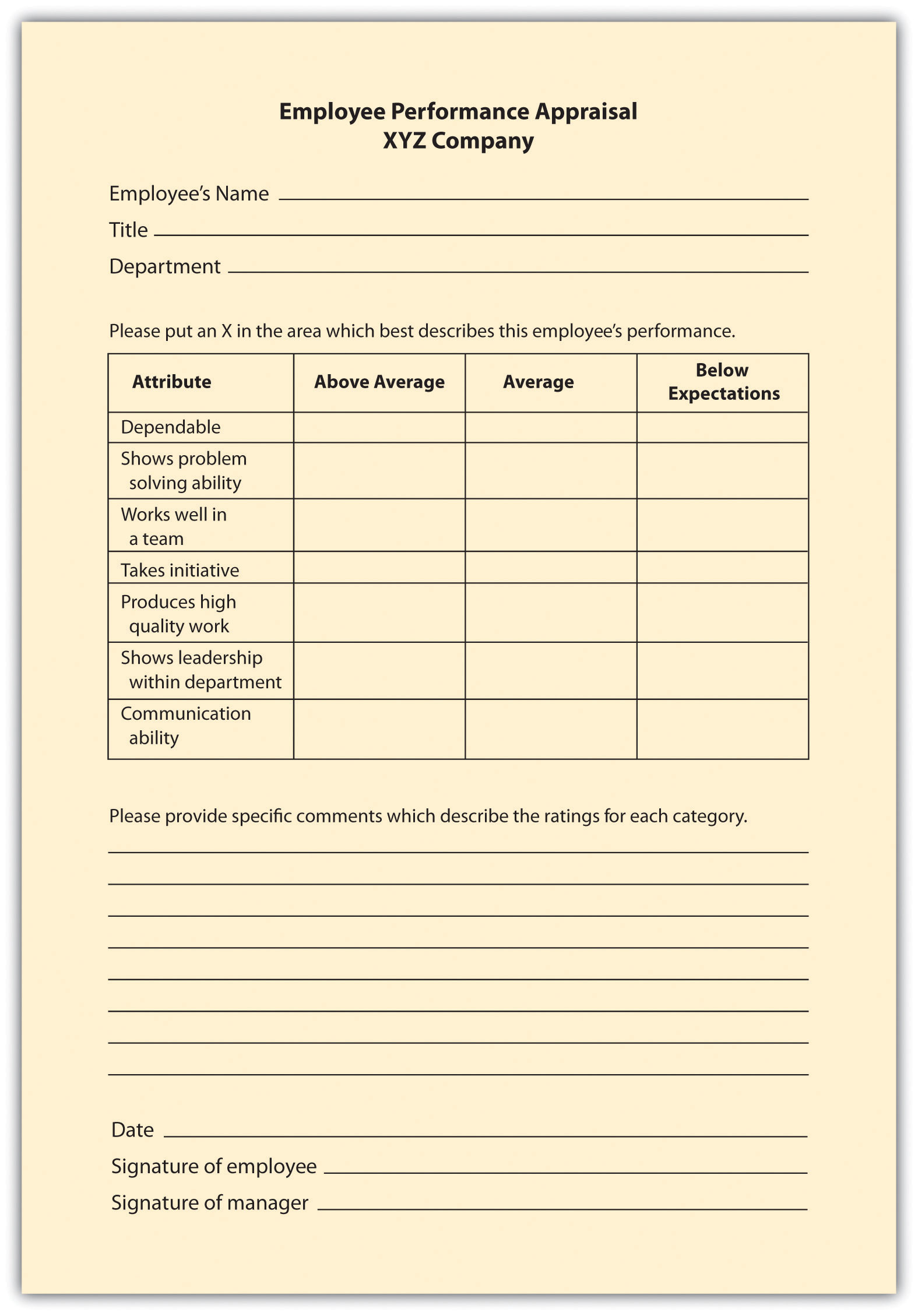Appraisal Methods
In this section, we will discuss some of the main methods used to assess performance. However, before discussing these methods, we must discuss how they approach the assessment of individual performance. Some methods focus on the employee’s specific traits in relation to the job. For these methods, the objective is to capture whether or not the employees possess the KSAO’s required for the job. An example would be to assess whether a salesperson is outgoing or whether the accounts payable clerks are conscientious and pay attention to detail. Another way to approach the assessment of performance is to look at individual actions within a specific job. This focus on behaviour, for example, would try to measure whether the salesperson uses a certain protocol when approaching customers or whether the accounts payable clerk follows up on her phone calls. The focus is on ‘what employees actually do’ as opposed to ‘who the employee is’ (for the trait methods). Comparative methods compare one employee with other employees. Finally, results methods are focused on objective employee accomplishments. Note that many organizations will use these methods in combination.
Graphic Rating Scale
The graphic rating scale, a trait method, is perhaps the most popular choice for performance evaluations. This type of evaluation lists the traits required for the job and asks the source to rate the individual on each attribute such as dependability and creativity. For example, the ratings can include a scale of 1–10; excellent, average, or poor; or exceeds, meets, or does not meet expectations.
| Poor | — | — | — | — | — | — | — | — | — | Exceptional |
| 0 | 1 | 2 | 3 | 4 | 5 | 6 | 7 | 8 | 9 | 10 |
The disadvantage of this type of scale is that it is quite subjective. Thus, many organizations use a graphic rating scale in conjunction with other appraisal methods to further solidify the tool’s validity. For example, some organizations use a mixed standard scale, which is similar to a graphic rating scale. This scale includes a series of mixed statements representing excellent, average, and poor performance, and the manager is asked to rate a “+” (performance is better than stated), “0” (performance is at stated level), or “−” (performance is below stated level). Mixed standard statements might include the following:
- The employee gets along with most coworkers and has had only a few interpersonal issues.
- This employee takes initiative.
- The employee consistently turns in below-average work.
- The employee always meets established deadlines.
Figure 7.2. Example of Graphic Rating Scale
Essay Appraisal
In an essay appraisal, the evaluator answers a series of questions about the employee’s performance in essay form. This can be a trait method and/or a behavioural method, depending on how the manager writes the essay. These statements may include strengths and weaknesses about the employee or statements about past performance. They can also include specific examples of past performance. The disadvantage of this type of method (when not combined with other rating systems) is that the manager’s writing ability can contribute to the effectiveness of the evaluation. Also, managers may write less or more, which means less consistency between performance appraisals by various managers.
Figure 7.3. Example of Essay Rating

Checklist Scale
A checklist method for performance evaluations lessens the subjectivity, although subjectivity will still be present in this type of rating system. With a checklist scale, a series of questions are being asked and the manager simply responds yes or no to the questions, which can fall into either the behavioural or the trait method, or both. Another variation to this scale is a check mark in the criteria the employee meets and a blank in the areas the employee does not meet. The challenge with this format is that it does not allow for more detailed answers and analysis of the performance criteria unless combined with another method, such as essay ratings.
Figure 7.4. Example of Checklist Scale

Critical Incident Appraisals
While Critical Incident Appraisals are more time-consuming to develop, they can be effective because they provide specific examples of behaviour to anchor the ratings. With a critical incident appraisal, the manager records examples of the employee’s effective and ineffective behaviour during the time period between evaluations, which is in the behavioural category. When it is time for the employee to be reviewed, the manager will pull out this file and formally record the incidents that occurred over the time period. The disadvantage of this method is the tendency to record only adverse incidents instead of positive ones. However, this method can work well if the manager has the proper training to record incidents (perhaps by keeping a weekly diary) in a fair manner. This approach can also work well when specific jobs vary greatly from week to week, unlike, for example, a factory worker who routinely performs the same weekly tasks.
Work Standards Approach
A work standards approach could be the more effective way of evaluating employees for certain specific jobs in which productivity is essential. With this results-focused approach, a minimum level is set and the employee’s performance evaluation is based on this level. For example, if a salesperson does not meet a quota of $1 million, this would be recorded as nonperforming. The downside is that this method does not allow for reasonable deviations. For example, if the quota is not met, perhaps the employee just had a bad month but normally performs well. This approach works best in long-term situations, in which a reasonable measure of performance can be over a certain period. For example, in an automotive assembly line, the focus is on how many cars are built in a specified period, and therefore, employee performance is measured this way. Since this approach is centered on production, it does not allow for rating of other factors, such as ability to work on a team or communication skills, which can be important parts of the job.
Ranking Methods
In a ranking method system (also called relative method), employees in a particular department are ranked based on their performance. This system is a comparative method for performance evaluations. This method is stack ranking of employees based upon individual performance appraisal ratings (numeric or classification). A performance distribution chart is developed to show what percentage are rated as poor, marginal, meets, and exceeds with respect to performance. Senior management of larger organizations sometimes conduct this method of ranking to determine if a company wide action is warranted – to cull poor performers and/or increase emphasis on performance improvement plans.


